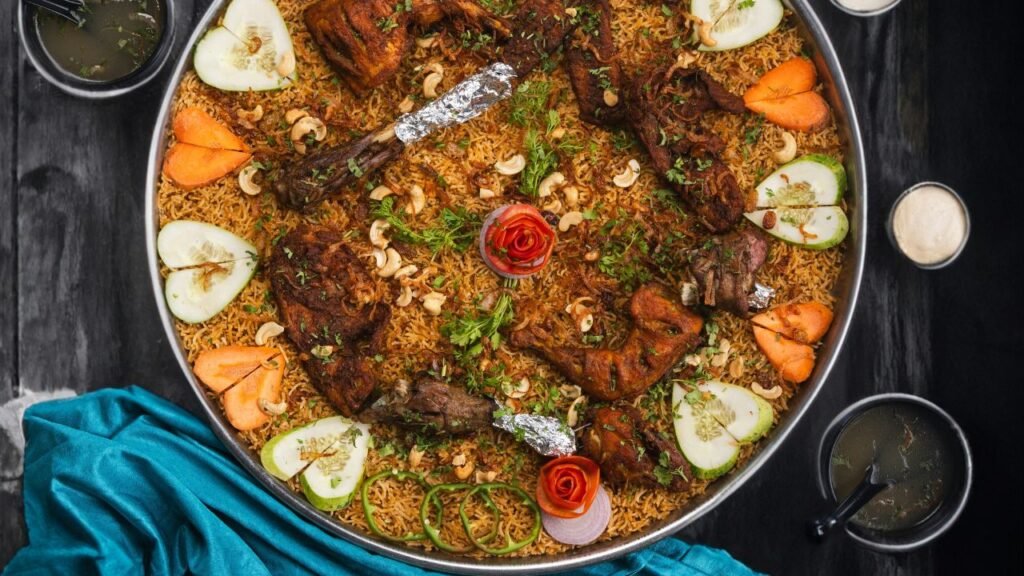
The History of Biryani
The history of biryani in India can be traced back to the Mughal Empire, which ruled much of the Indian subcontinent from the 16th to the 18th century. It is widely believed that the word “biryani” comes from the Persian word “birian,” meaning “fried” or “roasted.” The dish, in its early form, was likely brought to India by the Mughals and was a fusion of Persian pilaf and Indian cooking methods. The Mughals introduced elaborate and flavorful rice dishes to the Indian subcontinent, often combining basmati rice with meat, spices, and aromatic herbs.
The earliest biryanis were likely served in royal courts, with elaborate cooking techniques involving slow-cooking the meat and rice together, sometimes in sealed pots, allowing the flavors to meld together. These early versions of biryani were typically cooked with ingredients like saffron, cardamom, cinnamon, and cloves, which remain common in many biryanis today. Over time, the dish evolved in different regions, incorporating local ingredients and techniques, leading to the diversity of biryanis we see in India today.
The Evolution of Biryani Across India
While the Mughal influence on biryani is undeniable, the dish has adapted to the unique tastes, ingredients, and cooking methods of various regions of India. As the Mughal Empire declined, regional rulers and dynasties in different parts of the country embraced biryani, each putting their own spin on the classic dish. This led to the emergence of several distinct biryani styles that are now an integral part of Indian culinary culture.
Hyderabadi Biryani
One of the most famous biryanis in India is the Hyderabadi biryani, which emerged during the Nizam rule in the 18th century. Known for its rich, spicy flavor, Hyderabadi biryani is made with marinated meat, usually chicken or mutton, and basmati rice cooked with a unique blend of spices. The dish is often characterized by its use of yogurt and saffron in the marinade and its slightly greasy texture, which comes from the liberal use of ghee (clarified butter). The “kacchi” style, where marinated raw meat is cooked with partially cooked rice, is one of the most popular ways to prepare Hyderabadi biryani.
Lucknowi Biryani (Awadhi Biryani)
In the city of Lucknow, biryani took on a more refined, subtle flavor profile under the Nawabs of Awadh. The Lucknowi or Awadhi biryani is known for its delicate spicing and the use of fragrant, long-grain basmati rice. The meat is usually cooked separately from the rice and then layered, allowing the flavors to blend without being overpowering. Unlike the Hyderabadi biryani, Lucknowi biryani tends to have a milder taste, with a focus on the aromatic qualities of the spices.
Malabar Biryani
In Kerala, the Malabar biryani is a beloved dish, especially in the northern regions of the state. It is unique for its use of short-grain rice (Khyma rice), which gives it a different texture from the long-grain basmati used in other types of biryani. The Malabar biryani often uses fried onions, raisins, and cashews, which add a touch of sweetness to the spicy, savory flavor. The meat, usually chicken or mutton, is marinated with a mix of local spices, including cardamom, cinnamon, and cloves, and then cooked with the rice in a manner that retains the distinct flavors of both.
Kolkata Biryani
In the Bengali context, biryani has evolved to reflect the region’s rich cultural heritage. The Bengali biryani is believed to have been introduced during the reign of Nawab Wajid Ali Shah, who was exiled to Kolkata in the mid-19th century. The Kolkata biryani, known for its mild flavors, uses both chicken and mutton as the primary meats, but the standout feature of this biryani is the inclusion of potato. Unlike the other biryanis, Kolkata biryani features large chunks of boiled potato cooked along with the meat and rice. The potatoes absorb the flavors of the spices, making them an integral part of the dish.
Kolkata Biryani: The Royal Influence
Kolkata biryani owes its origins to the Nawab of Lucknow, Wajid Ali Shah, who was exiled to Kolkata in 1856 after the Indian Rebellion of 1857. During his stay in the city, the Nawab, who was an epicurean, sought to recreate the royal dishes from his homeland. The city’s local chefs, under his patronage, began making adaptations to the traditional Lucknowi biryani to suit the available ingredients and the local taste.
A defining feature of Kolkata biryani is its use of boiled potatoes, which were added to the dish as a way to make the biryani more filling and affordable, while still preserving the royal essence of the dish. The use of potatoes was a practical solution to provide a sense of abundance without adding additional meat, making the dish accessible to a larger population. The rich, fragrant rice, tender meat, and mildly spiced curry created a dish that became incredibly popular in Kolkata and across Bengal.
Barrackpore Style Biryani: A Distinct Variation
While Kolkata biryani is famous across the globe, there is another lesser-known but equally delicious variant—the Barrackpore style biryani. Barrackpore, a town situated on the outskirts of Kolkata, has its own unique take on the biryani, which differs from the Kolkata style in subtle but important ways. Barrackpore biryani is known for its more pronounced, richer flavors, with a greater emphasis on meat quality and marination.
In Barrackpore biryani, the meat is cooked more slowly, allowing the flavors to develop more deeply. There is also a greater focus on using spices like cinnamon, cardamom, and clove in combination with fried onions and caramelized garlic. This results in a biryani that is richer in flavor and often more fragrant than the lighter, milder Kolkata-style biryani. Additionally, Barrackpore biryani is typically served with a greater emphasis on the meat, as opposed to the potato-centric approach of Kolkata biryani.
DBAPI Biryani, a notable restaurant in Barrackpore, is often regarded as the flagbearer of this unique style. Their commitment to maintaining the traditional recipe while modernizing the customer experience has helped Barrackpore biryani gain wider recognition. It’s now considered one of the best representations of the Barrackpore style, and food lovers from Kolkata and beyond often make the journey to try it.
The Many Faces of Biryani in India Today
The evolution of biryani in India has led to the creation of a vast array of regional styles. Some of the most popular variants include:
Ambur Biryani (Tamil Nadu): Known for its spicy flavors and the use of Seeraga Samba rice, which gives the biryani a distinct texture.
Dindigul Biryani (Tamil Nadu): A unique style that uses small-grained rice and a much spicier masala, often cooked with beef.
Kolkata Biryani: The more famous version from Kolkata, with the signature potato addition and a milder spicing.
Barrackpore Biryani: A richer, more intense version of Kolkata biryani, focusing on meat and deep spicing.
Bangalore Biryani (Karnataka): Known for its use of local spices and a slightly tangier flavor due to the inclusion of yogurt.
Bihari Biryani: A flavorful biryani from Bihar, where the spices are heavier, and the meat often includes chicken or mutton.
Each of these variants, whether from Kolkata, Barrackpore, Hyderabad, or any other region, tells a story of local culture, ingredients, and traditions. Biryani’s evolution in India reflects the diversity of the country itself—where influences from royal courts, local kitchens, and colonial rulers have blended together over centuries.
Conclusion
From the royal kitchens of the Mughals to the bustling streets of modern-day India, biryani has evolved into a dish that represents both history and innovation. The many types of biryanis, including the renowned Kolkata and Barrackpore styles, are a testament to India’s rich culinary legacy. As this beloved dish continues to evolve, it remains a symbol of the country’s diverse food culture, bringing together tradition, taste, and the love of cooking.
Whether you’re indulging in a plate of Hyderabadi biryani, savoring a Kolkata biryani with its signature potato, or enjoying the deep flavors of Barrackpore biryani, you are partaking in a centuries-old tradition that has been lovingly passed down through generations.
